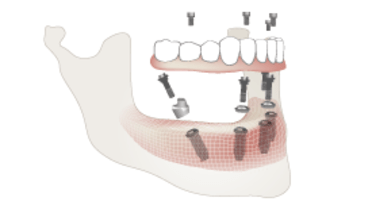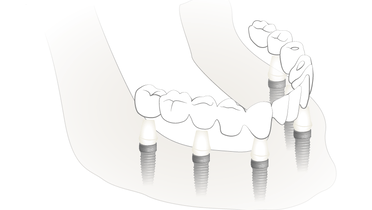-
0
Patient Assessment
- 0.1 Patient demand
- 0.2 Overarching considerations
- 0.3 Local history
- 0.4 Anatomical location
- 0.5 General patient history
-
0.6
Risk assessment & special high risk categories
- 5.1 Risk assessment & special high risk categories
- 5.2 age
- 5.3 Compliance
- 5.4 Smoking
- 5.5 Drug abuse
- 5.6 Recreational drugs and alcohol abuse
- 5.7 Parafunctions
- 5.8 Diabetes
- 5.9 Osteoporosis
- 5.10 Coagulation disorders and anticoagulant therapy
- 5.11 Steroids
- 5.12 Bisphosphonates
- 5.13 BRONJ / ARONJ
- 5.14 Radiotherapy
- 5.15 Risk factors
-
1
Diagnostics
-
1.1
Clinical Assessment
- 0.1 Lip line
- 0.2 Mouth opening
- 0.3 Vertical dimension
- 0.4 Maxillo-mandibular relationship
- 0.5 TMD
- 0.6 Existing prosthesis
- 0.7 Muco-gingival junction
- 0.8 Hyposalivation and Xerostomia
- 1.2 Clinical findings
-
1.3
Clinical diagnostic assessments
- 2.1 Microbiology
- 2.2 Salivary output
-
1.4
Diagnostic imaging
- 3.1 Imaging overview
- 3.2 Intraoral radiographs
- 3.3 Panoramic
- 3.4 CBCT
- 3.5 CT
- 1.5 Diagnostic prosthodontic guides
-
1.1
Clinical Assessment
-
2
Treatment Options
- 2.1 Mucosally-supported
-
2.2
Implant-retained/supported, general
- 1.1 Prosthodontic options overview
- 1.2 Number of implants maxilla and mandible
- 1.3 Time to function
- 1.4 Submerged or non-submerged
- 1.5 Soft tissue management
- 1.6 Hard tissue management, mandible
- 1.7 Hard tissue management, maxilla
- 1.8 Need for grafting
- 1.9 Healed vs fresh extraction socket
- 1.10 Digital treatment planning protocols
- 2.3 Implant prosthetics - removable
-
2.4
Implant prosthetics - fixed
- 2.5 Comprehensive treatment concepts
-
3
Treatment Procedures
-
3.1
Surgical
-
3.2
Removable prosthetics
-
3.3
Fixed prosthetics
-
3.1
Surgical
- 4 Aftercare
Direct to implant vs. abutment
Key points
- A prosthesis directly supported by implants is indicated when inter-arch distance is limited
- A prosthesis supported by abutments is indicated when implant angulation needs to be corrected, especially for screw-retained prosthesis designs
- Abutments designed for cement-retained restorations are preferred in situations where an access screw hole is not desired
- For a prosthesis directly supported by implants, soft tissues around implants must be carefully manipulated during impression and trial placement appointments
Advantages of abutment-supported prostheses
- When implants are not parallel to each other, the use of angulated abutments can "correct" for the non-parallelism.
- Angulated abutments are available for a screw-retained prosthesis.
- Custom abutments can be fabricated for a cemented prosthesis.
- Placement of abutments permits the abutment-prosthesis interface to be placed crestally or supra-crestally making impression-taking and trial placement much easier and less invasive for the soft tissues.
Disadvantages of abutment-supported prostheses
- When there is limited interarch space, placing abutments reduces the size and hence the strength of the prosthesis framework.
- The typical implant to prosthesis system involves two retentive interfaces of implant-abutment and abutment-prosthesis meaning that in the case of cement-rertained prostheses, access to the abutment screw may be difficult.
- Cement excess is a major cause for peri-implant inflammation and peri-implant crestal bone loss.
Advantages of implant-supported prosthesis
- When there is limited interarch space, this type of prosthesis allows for the necessary size and strength of the prosthesis framework.
- With the typical implant-prosthesis-prosthetic screw system, retrievability is enhanced.
- There is only one retentive mechanism to manage.
Disadvantages of implant-supported prosthesis
- Cannot be used with a cement-retained prosthesis.
- Non-parallelism of implants may lead to compromised esthetics due to the position of the access holes for the prosthetic screws.
- Impressions and trial placement procedures may traumatize the peri-implant soft tissues.
- Connection and disconnection of the prosthesis may influence the periimplant tissue condition/crestal bone levels.
- Connection and disconnection of the restoration may be more uncomfortable for the patient in comparison to an abutment supported prosthesis.
Clinical topics
Related articles
Additional resources
Questions
Ask a question
Log in or sign up to continue
You have reached the limit of content accessible without log in or this content requires log in. Log in or sign up now to get unlimited access to all FOR online resources.
No payments necessary - FOR is completely free of charge.




